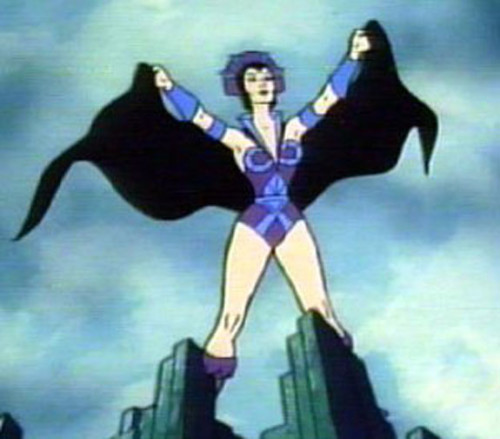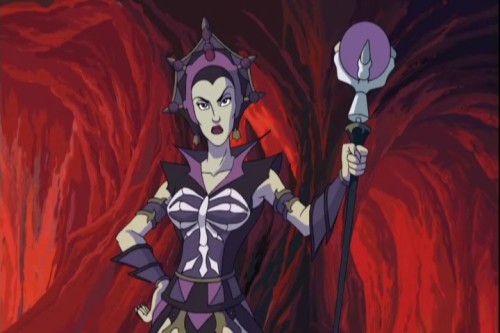This guest post by Robert Aldrich appears as part of our theme week on Unlikable Women.
The female antagonist has historically been an underwritten, under-explored, and often under-appreciated role in fiction. Going back throughout history, the female villain has almost invariably been seen as more novelty than respected foe, more a token deviation from the norm than anything worthy of real development. The trend started in the modern era with Irene Adler testing her mettle against Sherlock Holmes in the short story “A Scandal in Bohemia,” though by the time comics and sci-fi/fantasy had come into their own, most heroes had their “token women opponents.” Going further, we can find a few sparse and rare examples, such as Milady de Winter from Alexander Dumas’ The Three Musketeers, Morgan LeFay in the Arthurian Legend, all the way perhaps to Delilah in the Biblical story of Sampson.
While literature was at times more progressive, television and movies still depicted the female antagonist as one who relies on guile and lies (and maybe sex appeal depending on the writers and the era), but rarely if ever are they seen as comparable adversaries. From James Bond to the A-Team, from Flash Gordon to the sword-and-sandal epics of the 1950s into the 1980s, most female antagonists were evil queens or villainous witches who send forth minions to do their work. They were bosses or femme fatales who enacted complex schemes but who faltered when confronted directly with the hero. This is often because no matter how powerful they may appear to be socially, their actual might is negligible. And moreover, they tend to disappear as randomly as they appeared, providing a single-story novelty of the woman-villain, or the feminine agent who only seemed to exist to facilitate the plans of their male superiors.
Then came Evil-Lyn.
Joke all you want about the corniness of 1983’s He-Man and the Masters of the Universe cartoon series (and there’s plenty to joke about), but the show’s writers created a wholly underappreciated female icon in Evil-Lyn, the self-titled Sorceress of Darkness. A character with few rivals and even fewer scruples, Evil-Lyn was arguably one of the better developed villains in the show. And in the annals of females from sci-fi/fantasy, her name should be spoken of in the same breath as Wonder Woman and Princess Leia.
The world of He-Man is one of classical pulp fantasy. Science and high technology co-exist on a world that is full of marvels that defy comprehension (and sometimes reason). Benevolent monarchs, feudal societies, and creatures of more varieties than can be imagined, all make up the foundations of daily life. It’s here on Eternia, a world at the center of the universe, that cosmic forces are personified as colorful individuals or encapsulated in simple objects such as rods, gems, staves, and swords.
Over the course of the show, we’re introduced to a menagerie of dynamic characters like He-Man, Skeletor, Orko, as well as many other fan favorites. Among the many characters are three prominent females: the Sorceress (a pseudo-deity who sees over the forces of good), Teela (Captain of the Royal Guard and sidekick to He-Man), and Evil-Lyn. Initially conceived as a counterpart to Teela in the action figure toy line (because this was the 1980s and of course there was a toy line), Evil-Lyn would almost immediately transcend that balancing role and become something different, something outside the hierarchy of power and roles found in most traditional fantasy stories.
Probably the most distinctive element of Evil-Lyn was her thirst for power, which was terrifying considering the power she already commanded. Evil-Lyn’s magical might was matched by very few (principally only Skeletor himself, the show’s primary villain, and the Sorceress of Grayskull). Outside of those two key and central figures, Evil-Lyn had few if any peers.
Also fundamental to her character, as well as underscoring her magical prowess, is that Evil-Lyn never demonstrated any combat prowess. While not unheard of for female characters in traditionally male-targeted shows, she stands out in a show like He-Man because everybody is a master combatant. The aforementioned Teela is the Captain of the Royal Guard and debateably as capable a fighter as He-Man. The Sorceress, from whom pretty much all the powers of good derive their might, gets involved in many a battle (often in the form of a great falcon known as Zoar). Even He-Man’s own mother, Queen Marlena, is actually a combat pilot (Lt. Marlena Glenn, and reputedly one of Earth’s first female astronauts). Every woman in this show was capable of throwing down, except Evil-Lyn.
This isn’t a short-coming on her part, however. It’s a testament. In a world where physical might and combat prowess are universally required, that she doesn’t have (or certainly never demonstrates) the requisite skills speaks volumes to the intelligence, cunning, and magical might that she does command. Unlike the “evil witches” in other fantasy stories, however, Evil-Lyn doesn’t rely on henchmen or artifacts to work her will. She is shown throughout the run of the show to have little need for henchmen or intermediary agents, nor does she often rely on magical amulets or great artifacts. Even her oft-present orb staff appears to be more trinket than necessity. Her magic is her own and she has more than enough for almost any need.
While Evil-Lyn is powerful, she is also ambitious. Her role as Skeletor’s aide is on the promise that he will grant her greater power (or that she will take his when the opportunity presents itself). Beyond working with Skeletor, Evil-Lyn works with anyone else she chooses, more than occasionally executing her own schemes independent of Skeletor’s plans or ambitions, loaning out her skills and knowledge to other malevolent forces in the pursuit of greater power.
The 1987 live-action movie deviated somewhat from the depiction of Evil-Lyn, but only in downplaying the verbose demeanor she showed in the cartoon and replaced it with a colder and harsher, otherworldly presence. Played by Meg Foster, Evil-Lyn showed fewer magical powers and less boisterous personality, but she lost none of her critical role to Skeletor. Indeed, we see instances where he confides that his success in conquering Eternia and holding the people is due almost solely to her, while there are hints of perhaps more than a partnership (maybe even romance?) at play between the two.
Almost two decades after the first series aired, He-Man would be rebooted for the 2002 animated series. This series would develop Evil-Lyn even further as well as more firmly establish her as more than mere henchman to Skeletor. She undermines Skeletor’s plans by aligning with other factions (namely Kobra Khan and the Snake Men), all in the pursuit of power. In the wake of this betrayal, we learn that Skeletor and she once were partners before he was turned into the deformed warrior-wizard we all know today.
Looking at Evil-Lyn as a character, she was almost without peer. Never before in pop culture – especially children’s entertainment – had a female character been so unmitgatingly evil, so self-serving, and yet so powerful. In the He-Man franchise, she is one of the great powers of the world, whom no one dares underestimate. She has no minions, and has no need for any. She is no diabolical queen, sitting scheming atop a throne, and hiding behind others. She is a mercenary who does what she wishes and goes where she pleases.
Robert V Aldrich is a novelist and speaker based out of North Carolina. His most recent book, Rhest for the Wicked, is now available, and he publishes a blog and serials at his website, TeachTheSky.com. You can follow him there, or on Twitter @rvaldrich.





Thanks for the analysis, she was always one of my favorite MOTU villains!